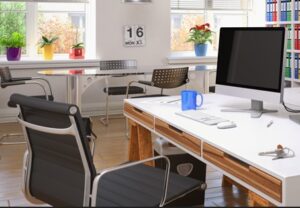Use of home for UK Business
Small businesses are base at home. It means the director work from home to run the company. From the tax year of 2022-23 onwards, there was an optional flat rate deduction basis. So that these businesses can claim an amount back for using a room/rooms at home for business purposes. Based on apportioning actual expenses. These costs that businesses may able to claim back on include part of the bills for light, heating, water and rent/mortgage interest.
In order to make the claims possible, it is important to keep the original bills as evidence of amounts paid. This will how the proportion has been calculated. HMRC has set a view on what can claim.
Two methods for calculating business use of home
Your business is eligible to use the new simplified accounting method. You have a couple of options for working out. How much to claim for business use of home as office limited company?
If you’re a sole trader or in a partnership, where all the partners are individuals rather than limited companies. You will eligible to use the simplified accounting method. One option, this method of accounting allows is a flat rate calculation for business use of home.
The flat rate method
The flat rate method simply asks you to look at how many hours a month you spend running your business at home. It will on average and include a fixed amount in your accounts for business use of home.
The amount varies with the number of hours per month you work at home, as follows:
- £10 a month for 25 hours to 50 hours working from home
- £18 a month for over 50 to 100 hours
- £26 a month for over 101 hours
Flat rate covers all household goods and services. This includes food, drink and utility bills but not mortgage interest or rent and council tax.
The costs method
If your business is a limited company. You’re not eligible to use the simplified accounting method. You’ll have to use the costs method. The amount you can claim using the costs method depends on the type of business you have? What work you actually do at home?
What is ‘the costs method’ is influenced by some of the following factors. As there are no set rules on what is the costs method:
- Size of the ‘office’ in relation to the whole property.
- Hours spent working from home.
- The types of equipment that are used and how much electricity or power they use.
- Whether the occupied is exclusively for business or use a room for domestic purposes as well.
- The number of other people living in the property.
The business premises is a type like a pub or hotel. Then there are some adjustments:
- One occupant – £350 a month
- 2 occupants – £500 a month
- 3 or more occupants – £650 a month
What running costs can you include in your accounts?
This is the key issue. HMRC likes to assume that use of part of the home is occasional. When a room is not being use for the trade, etc.. Then it is being used privately. That may appropriate when using a dining room to do the books for a couple of hours in an evening. But not when a room is given over to the business – typically a home office, made out of a bedroom, study, or utility room.
For expenses, such as mortgage interest, council tax, and insurance
It may appropriate to consider the number of rooms in the house. It will apportion based on the number of rooms used for business purposes. Traditionally, the kitchen, bathrooms, and similar ‘ancillary’ rooms are ignored (I think a modern ‘kitchen diner’ might have to be included, however, where it could be considered a usable ‘living’ room).
Repairs and cleaning expenses
Repairing can dealt with in different ways. Re-tiling the bathroom, for example, would not be deductible as it has no bearing on your office space. But repairing the roof could be apportioned. As with mortgage interest, as the roof applies to the building as a whole. Re-decorating the home office itself would be wholly allowable unless there was significant private use of that room.
Heat and light
The heating will reflect actual usage. But this may not necessarily result in a small claim. If I work from home through the winter months that may be the only reason the house is heated during the day, while the rest of the family is out at work or school.
Use of water
HMRC thinks that most businesses run from home do not use water. On reflection, this is probably fair unless perhaps hairdresser or dog groomer.
Telephone and broadband costs
It is often claimed separately anyway, with an appropriate restriction for private use.
How do I justify a higher claim?
The below formula is a good basis for calculating an apportioned charge for a use of home as office claim:
B + (D% x C) x E = F
A
Where:
A = The total number of rooms in the home
B = The number of rooms dedicate solely for business use
C = The number of rooms use partly for business and partly for personal use
D = The percentage of time spent for business use in comparison to personal use
E = The total home expenditure including water and sewerage, rent, mortgage interest, heat and light, buildings insurance.
Calculating the ‘number of rooms’ method annually for your utilities would follow this example formula:
Annual mortgage interest: £6,798
Heat and light: £2,400
Council tax: £1,750
Water rates: £450
Total: £11,398
This figure will divide the number of rooms. Under the assumption that each one uses the same amount of electricity. So if you had a seven-room home and used one as your workspace. You can claim £1,628 per year.
For the ‘total time’ calculation, you would first divide £1,628 by the number of hours in a week (168). Then multiply this sum by how many hours you spent working at home. If this time was 30 hours each week, then you would claim £290 per year.


